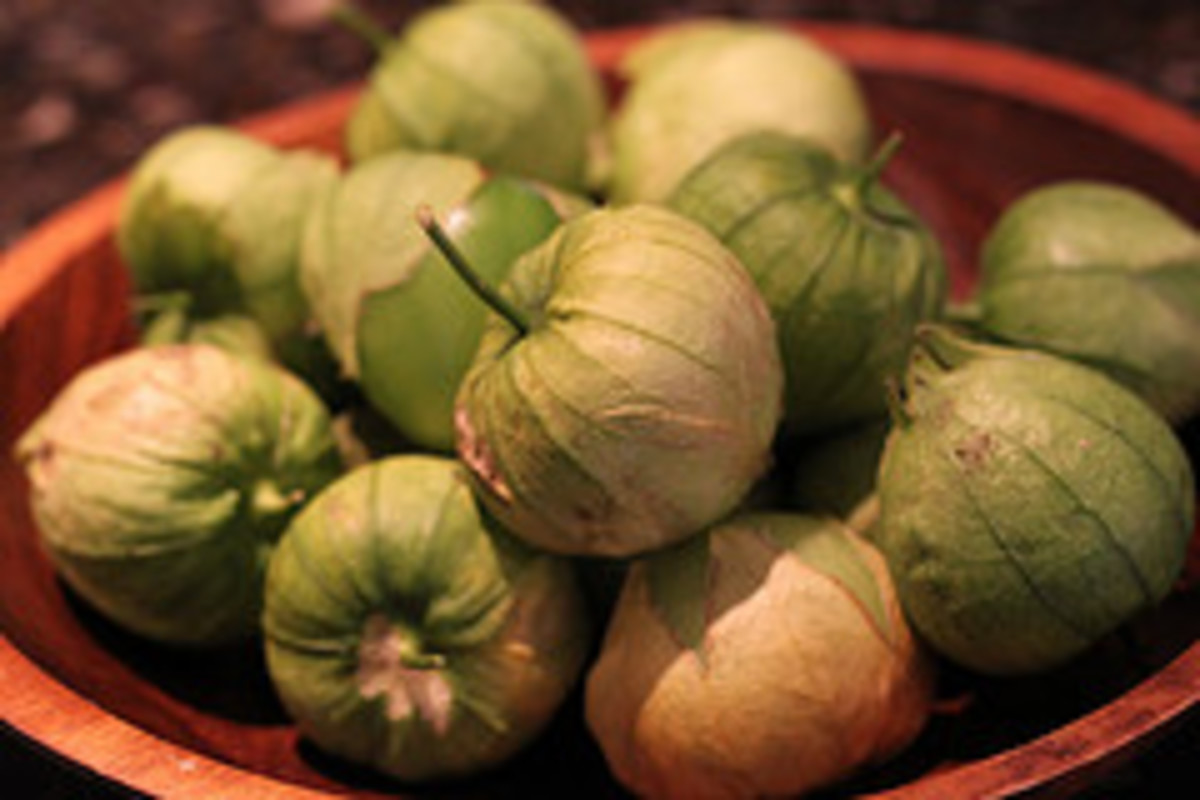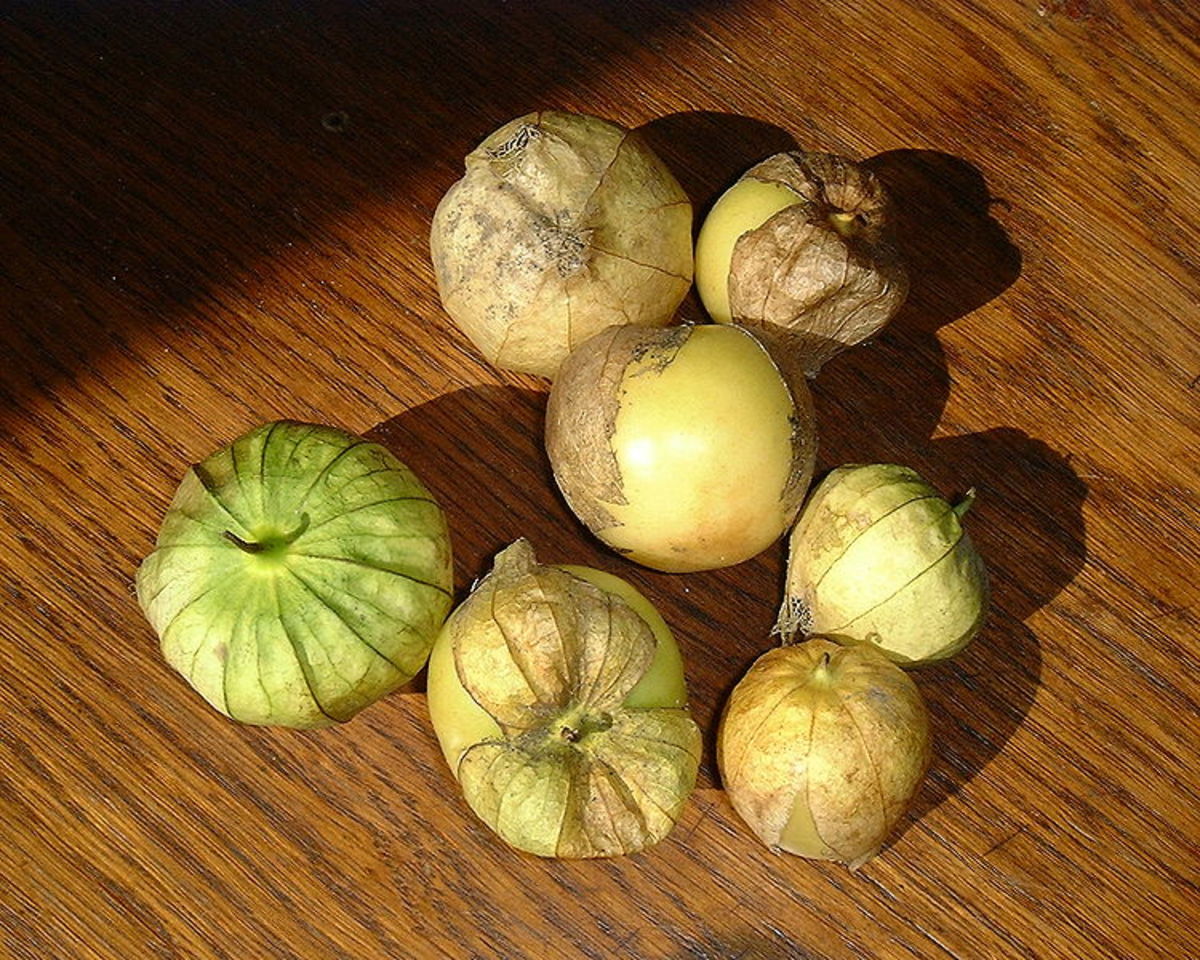How to Make Easy and Delicious Tomatillo Salsa Verde
Fresh & Easy Salsa Verde in a Molcajete
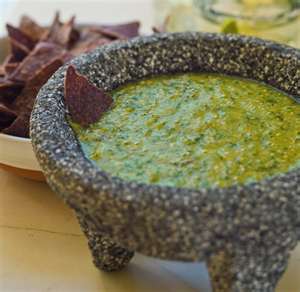
A Young Tomatillo Plant Grown from Seed
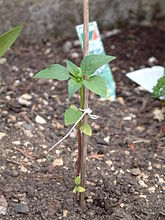
A Tomatillo Flower

The Fascinating Tomatillo
Many people mistakenly think that the spicy green salsa served in Mexican restaurants is made from green tomatoes; it is not, the main ingredient is instead the interesting tomatillo.
The tomatillo (Physalis philadelphica ) is a sprawling plant of the nightshade family that bears small, spherical, green or green-purple fruit protected by papery husks. Tomatillos are a staple in Mexican cuisine and the key ingredient in salsa verde, the ubiquitous green sauce used in a wide variety of dishes, both traditional and or of recent creation. Tomatillos are tender plants, quickly killed by frost, and are therefore grown as annuals in cooler climates. The plants are often self-incompatible, which means they cannot self-pollinate and require a second plant nearby in order to guarantee a crop.
Although tomatillos are sometimes called "green tomatoes", they should not be confused with green, unripe tomatoes; tomatoes belong to the same botanical family as the tomatillo (Solanaceae ), but are classified in a different genus. Tomatillos are more closely related to the Cape gooseberry (Physalis peruviana ), which grows wild in a wide range of habitats in both the new and old worlds.
The technical classification of the tomatillo is as follows:
Kingdom: Plantae: Angiosperms: Eudicots (unranked): Asterids
Order: Solanales Family: Solanaceae Genus: Physalis
Species: P. philadelphica
Ripe Tomatillos
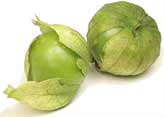
Cooking with Tomatillos
Ripe tomatillos should be firm and very bright green; the green color and tart, acidic flavor are their main culinary contributions. The purple and red-ripening varieties have a mild sweetness—unlike the green-ripening cultivars—and are therefore more suitable for fruit-like uses like jams and desserts. Like their close relative the Cape gooseberry, tomatillos have a very high pectin content and are therefore added to preserves in order to gel the mixture. Another distinguishing characteristic is a sticky coating on the fruit, located on the underside of the papery husk. Fortunately, it rinses off with plain water.
Tomatillos are not difficult to grow, although the plants tend to become long, unruly tendrils that take up a lot of space in the garden and keep trying to take over the entire yard. Their needs are much the same as tomato plants, although they are more difficult to keep within the bounds of a cage. Because they need warmth right from the start, the plants need to be started from seed very early, so buying young plants is easier, although, unless you are fortunate enough to live in an area with a large Latino population, it can be difficult to find the plants in garden centers. Ask for them; next year they may be right there to buy.
Ripe tomatillos will keep for about two weeks if refrigerated. They will last even longer if the husks are removed and the fruits are refrigerated in sealed plastic bags. They may also be frozen whole or sliced for future use.
Authentic, Fresh & Easy Salsa Verde
Easy to make and so delicious!
Cook Time
Tomatillos Ready for Salsa Verde
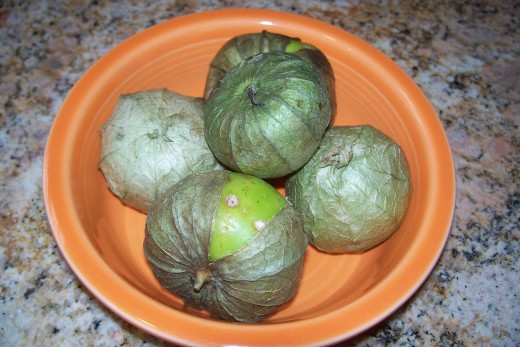
Ingredients
- 6 Large Tomatillos
- 1/2 Medium white or red onion, Coarsely chopped
- 1 Serrano pepper, Stemmed, seeded and coarsely chopped
- 1/2 Large Poblano pepper, Stemmed, seeded and coarsely chopped
- 1 Large clove garlic, Coarsely chopped
- 1/2 cup Cillantro leaves, Firmly packed in measuring cup
- 1 T. Lime juice
- 1/2 t. sugar or stevia
How hot do you like it?
For more heat, add 1 small jalapeno pepper, stemmed, seeded and coarsely chopped. For a milder salsa, substitute any mild pepper for all or part of the serrano and poblano peppers.
Cut the tomatillos in half
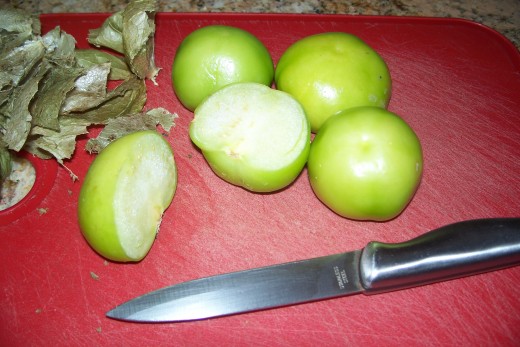
Remove the stems from the tomatillos
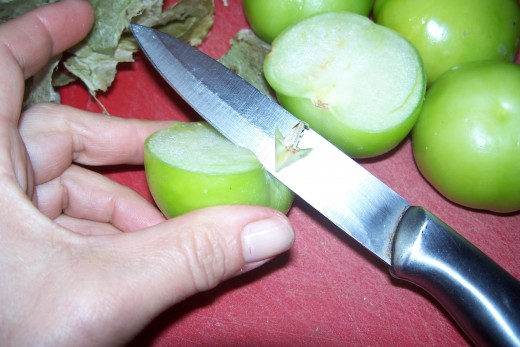
How to Make Perfect Salsa Verde
- Remove the papery husks from the tomatillos and rinse them well.
- Cut the tomatillos in half and place cut side down in a baking pan lined with non-stick aluminum foil. Place under a broiler for about 5-7 minutes to lightly blacken the skin. Chill in refrigerator for 10 minutes. Peel off the blackened skin.
- Put peeled tomatillos, lime juice, onions, cilantro, serrano peppers, garlic, and sugar in a food processor (or blender) and pulse until all ingredients are finely chopped and well mixed. Season to taste with salt. Chill in refrigerator and serve with chips and with any southwestern dish.
Place tomatillos in foil lined pan
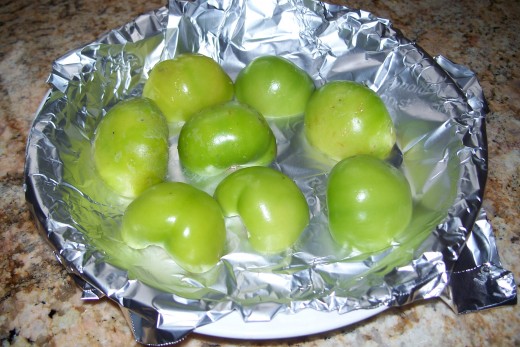
Broil tomatillos until blackened
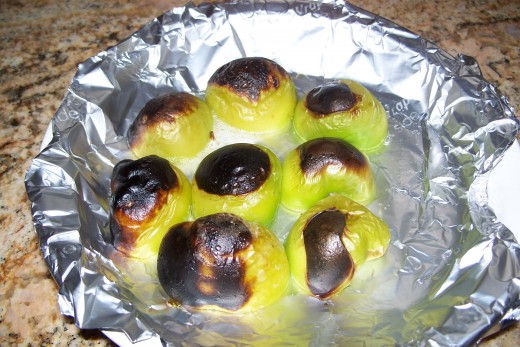
Poblano & serrano peppers, onion, garlic
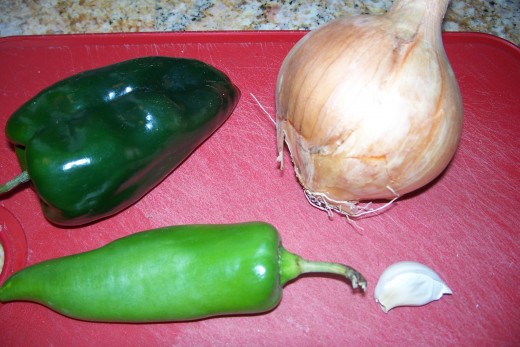
Chop cillantro
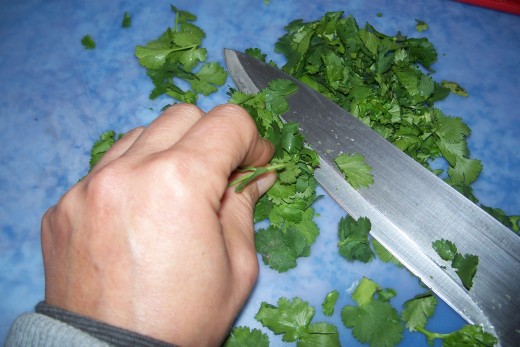
Wonderful salsa recipes:
The Ancient Aztec Molcajete
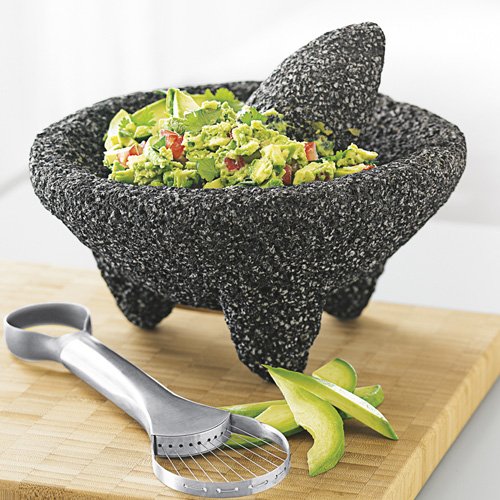
Grind cillantro into the garlic & lime juice
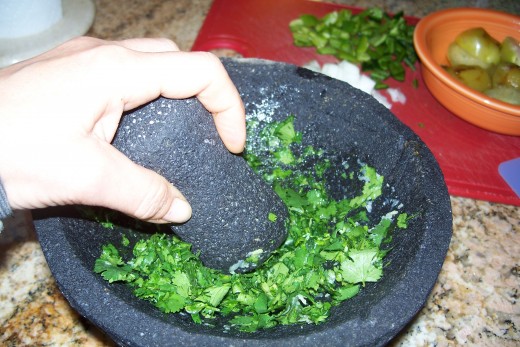
Add peppers & tomatillos and grind and pound together
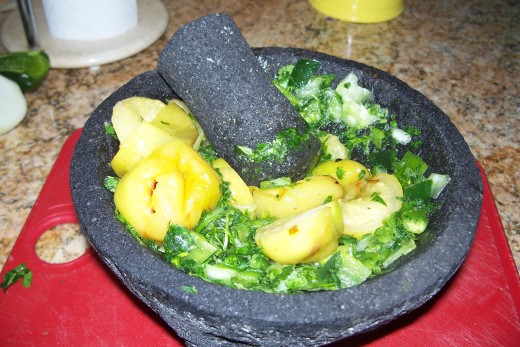
A good selection of authentic molcajetes from which to choose:
How to Make Salsa Verde with a Molcajete
If you have one, you can also use a molcajete (pronounced: mol-keh-hey-tey) to make salsa verde. A molcajete is an authentic Mexican mortar and pestle, hand carved of volcanic stone and perfect for grinding herbs and for mixing salsas and guacamole. Evidence of the use of the molcajete goes back thousands of years into the distant past of pre-Hispanic Mesoamerica, evolving from the metate , a primitive stone slab used for grinding food ingredients. In Nathuatl, the language of the Aztecs, molcajete means “sauce bowl.” Mine was a gift, and I use it to prepare and serve guacamole as well as to make wonderful fresh green and red salsas.
If you use a molcajete, chop the onion and peppers a bit finer and chop the cilantro and tomatillos a bit as well. Start by grinding the garlic clove with the lime juice and sugar, then add and grind and pound together the onion and peppers and finally add the broiled, peeled, chopped tomatillos, giving the salsa a final grinding to mix everything together. I prefer the coarser, chunkier salsa made in my molcajete to one made in a processor. As crazy as it sounds, everything simply tastes better when made in the molcajete, and looks spectacular served it in, as well.
Salsa verde is a versatile sauce that can be used chilled, at room temperature or heated. Serve it cold with chips; use a spoonful as the bottom layer of ceviche; serve burritos or fajitas on a pool of warm salsa verde.
Although it’s wonderful fresh, I like to make a huge batch at the end of summer and freeze the salsa in small containers to have a taste of summer in the midst of winter.
Enjoy!
(I am an artist and the author of the Suburban Sprawl series of novels as well as two nonfiction books. Find out more about my work at RobertaLeeArt.com.)
Copyright © Roberta Lee 2012. All rights reserved.
Molcajete? I.....
You might also enjoy:
- How to Grow Your Own Nutritious and Delicious Sprouts
Growing your own sprouted seeds and beans is a rewarding, fun hobby that will give you one of nature's most nutritious and delicious foods. Also, here's an easy recipe for Shrimp, Avocado & Radish Sprout Ceviche. - How to Make Perfect Chili Rellenos
Perfectly made Chili Rellenos are one of the masterpieces of traditional Mexican cooking. With a silky smooth interior and a slightly crisp coating, this dish of few ingredients can be dauntingly difficult to make. My recipe will take you through the

![Salsas and Moles: Fresh and Authentic Recipes for Pico de Gallo, Mole Poblano, Chimichurri, Guacamole, and More [A Cookbook]](https://m.media-amazon.com/images/I/51n-sCyvhHL._SL160_.jpg)

